Variation in Spectral Characteristics of Dissolved Organic Matter and Its Relationship with Phytoplankton of Eutrophic Shallow Lakes in Spring and Summer
Abstract
:1. Introduction
2. Materials and Methods
2.1. Study Area
2.2. Sample Collection and Processing
2.3. 3DEEM Measurement and Indices Calculation
2.4. Data Analysis
3. Results and Discussion
3.1. DOM Spectral Fingerprint Analysis of Overlying Water in Shahu Lake
3.2. Variation Characteristics of Phytoplankton in Shahu Lake from April to July
3.3. Analysis of DOM Component Characteristics and Main Sources
3.4. Influence Factors of DOM Composition in Overlying Water of Shahu Lake
4. Conclusions
Author Contributions
Funding
Data Availability Statement
Conflicts of Interest
References
- Ho, J.C.; Michalak, A.M.; Pahlevan, N. Widespread global increase in intense lake phytoplankton blooms since the 1980s. Nature 2019, 574, 667–670. [Google Scholar] [CrossRef] [PubMed]
- Zhou, J.; Qin, B.Q.; Han, X.X.; Zhu, L. Turbulence increases the risk of microcystin exposure in a eutrophic lake (Lake Taihu) during cyanobacterial bloom periods. Harmful Algae 2016, 55, 213–220. [Google Scholar] [CrossRef] [PubMed]
- Zhang, F.F.; Harir, M.; Moritz, F.; Zhang, J.; Witting, M.; Wu, Y.; Schmitt-Kopplin, P.; Fekete, A.; Gaspar, A.; Hertkorn, N. Molecular and structural characterization of dissolved organic matter during and post cyanobacterial bloom in Taihu by combination of NMR spectroscopy and FTICR mass spectrometry. Water Res. 2014, 57, 280–294. [Google Scholar] [CrossRef] [PubMed]
- Zhou, Y.; Davidson, T.A.; Yao, X.; Zhang, Y.; Erik, J.; Garcia, D.; Wu, H.; Shi, K.; Qin, B. How autochthonous dissolved organic matter responds to eutrophication and climate warming: Evidence from a cross-continental data analysis and experiments. Earth Sci. Rev. 2018, 185, 928–937. [Google Scholar] [CrossRef]
- Zhang, H.; Zheng, Y.; Wang, X.C.; Wang, Y.; Dzakpasu, M. Characterization and biogeochemical implications of dissolved organic matter in aquatic environments. J. Environ. Manag. 2021, 294, 113041. [Google Scholar] [CrossRef] [PubMed]
- Derrien, M.; Brogi, S.R.; Goncalves-Araujo, R. Characterization of aquatic organic matter: Assessment, perspectives and research priorities. Water Res. 2019, 163, 114908. [Google Scholar] [CrossRef]
- Jia, S.Q.; Yang, F.; Wang, X.H.; Bai, Y.W.; Ma, W.J.; Li, Q.H.; Liao, H.Q.; Chen, S.H. Relationship between DOM components and phytoplankton in Baiyangdian Lake in autumn. Environ. Pollut. Control. 2021, 43, 1101–1107. [Google Scholar] [CrossRef]
- Zhang, Y.; Dijk, M.A.V.; Liu, M.L.; Zhu, G.W.; Qin, B.Q. The contribution of phytoplankton degradation to chromophoric dissolved organic matter (CDOM) in eutrophic shallow lakes: Field and experimental evidence. Water Res. 2009, 43, 4685–4697. [Google Scholar] [CrossRef] [PubMed]
- Carmen, T.D.; Jasmine, E.S.; Lafrancois, B.M.; Kevin, S.S. Effects of increased concentrations of inorganic nitrogen and dissolved organic matter on phytoplankton in boreal lakes with differing nutrient limitation patterns. Aquat. Sci. 2015, 77, 511–521. [Google Scholar]
- Rochelle-Newall, E.J.; Fisher, T.R. Production of chromophoric dissolved organic matter fluorescence in marine and estuarine environments: An investigation into the role of phytoplankton. Mar. Chem. 2002, 77, 7–21. [Google Scholar] [CrossRef]
- Li, Y.P.; Zhang, L.; Wang, S.R.; Zhao, H.C.; Zhang, R. Composition, structural characteristics and indication of water quality of dissolved organic matter in Dongting Lake sediments. Ecol. Eng. 2016, 97, 370–380. [Google Scholar] [CrossRef]
- Song, X.N.; Yu, T.; Zhang, Y.; Zhang, Y.; Yin, X.Y. Distribution characterization and source analysis of dissolved organic matters in Taihu Lake using three dimensional fluorescence excitation-emission matrix. Acta Sci. Circumstantiae 2010, 30, 2321–2331. [Google Scholar] [CrossRef]
- Zhao, H.C.; Li, Y.P.; Wang, S.R.; Jiao, L.X.; Zhang, L. Fluorescence characteristics of DOM in overlying water of Erhai Lake and its indication of eutrophication. Spectrosc. Spectr. Anal. 2019, 39, 3888–3896. [Google Scholar]
- Wang, X.P.; Zhang, F.; Yang, S.T.; Ayinuer, Y.; Chen, Y. Rapid diagnosis of surface water salt content (WSC) in Ebinur Lake watershad based on 3-D fluorescence technology. Spectrosc. Spectr. Anal. 2018, 38, 1468–1475. [Google Scholar]
- Zhang, L.; Sun, Q.X.; You, Y.; Zhang, K.; Gao, C.D.; Peng, Y.Z. Compositional and structural characteristics of dissolved organic matter in overlying water of the Chaobai River and its environment significance. Environ. Sci. Pollut. Res. 2021, 28, 59673–59686. [Google Scholar] [CrossRef]
- Cui, B. Study on Spectral Fingerprint Characteristics of Dissolved Organic Matter in Sand Lake and Its Response Mechanism to Water Quality and Algal Bloom. Master’s Thesis, Shandong Normal University, Jinan, China, 2021. [Google Scholar]
- Li, J.Y.; Zhang, Y.F.; Yang, Z.; Wang, M. Bacterial diversity in Shahu lake, northwest China is significantly affected by nutrient composition rather than location. Ann. Microbiol. 2017, 67, 469–478. [Google Scholar] [CrossRef]
- Li, P.Y.; Feng, W.; Xue, C.Y.; Tian, R.; Wang, S.T. Spatiotemporal Variability of Contaminants in Lake Water and Their Risks to Human Health: A Case Study of the Shahu Lake Tourist Area, Northwest China. Expo. Health 2017, 9, 213–225. [Google Scholar] [CrossRef]
- Chen, J.; Qian, H.; Gao, Y.Y.; Wang, H.K.; Zhang, M.S. Insights into hydrological and hydrochemical processes in response to water replenishment for lakes in arid regions. J. Hydrol. 2020, 581, 124386. [Google Scholar] [CrossRef]
- MEP of PRC (Ministry of Environmental Protection of the People’s Republic of China). Environmental Quality Standards for Surface Water (GB3838-2002); China Environmental Science Press: Beijing, China, 2002; Volume 6, pp. 8–9.
- MEP of PRC (Ministry of Environmental Protection of the People’s Republic of China). Water Quality—Determination of Chlorophyll A—Spectrophotometric Method (HJ 897-2017); China Environmental Science Press: Beijing, China, 2017.
- Wilske, C.; Herzsprung, P.; Lechtenfeld, O.J.; Kamjunke, N.; Einax, J.W.; von Tümpling, W. New Insights into the Seasonal Variation of DOM Quality of a Humic-Rich Drinking-Water Reservoir—Coupling 2D-Fluorescence and FTICR MS Measurements. Water 2021, 13, 1703. [Google Scholar] [CrossRef]
- Huguet, A.; Vacher, L.; Relexans, S.; Saubusse, S.; Froidefond, J.M.; Parlanti, E. Properties of fluorescent dissolved organic matter in the Gironde Estuary. Org. Geochem. 2009, 40, 706–719. [Google Scholar] [CrossRef]
- Ohno, T. Fluorescence inner-filtering correction for determining the humification index of dissolved organic matter. Environ. Sci. Technol. 2002, 36, 742–746. [Google Scholar] [CrossRef] [PubMed]
- Stedmon, C.; Bro, R. Characterizing Dissolved Organic Matter Fluorescence with Parallel Factor Analysis: A Tutorial. Limnol. Oceanogr. 2008, 6, 572–579. [Google Scholar] [CrossRef]
- Zeng, Z.; Zheng, P.; Ding, A.Q.; Zhang, M.; Abbas, G.; Li, W. Source analysis of organic matter in swine wastewater after anaerobic digestion with EEM-PARAFAC. Environ. Sci. Pollut. Res. 2017, 24, 6770–6778. [Google Scholar] [CrossRef] [PubMed]
- Yu, B.X.; Liu, D.P.; Wang, J.; Sun, Y.X. Insight into removals of PARAFAC components from dissolved and particulate organic matter in wastewater treatment process by two-dimensional correlation and structure equation modeling. Environ. Sci. Eur. 2021, 33, 118. [Google Scholar] [CrossRef]
- Baker, A.; Inverarity, R. Protein-like fluorescence intensity as a possible tool for determining river water quality. Hydrol. Process. 2004, 18, 2927–2945. [Google Scholar] [CrossRef]
- Baker, A.; Curry, M. Fluorescence of leachates from three contrasting landfills. Water Res. 2004, 38, 2605–2613. [Google Scholar] [CrossRef]
- Lu, K.T.; Gao, H.J.; Yu, H.B.; Liu, D.P.; Zhu, N.M.; Wan, K.L. Insight into variations of DOM fractions in different latitudinal rural black-odor waterbodies of eastern China using fluorescence spectroscopy coupled with structure equation model. Sci. Total Environ. 2022, 816, 151531. [Google Scholar] [CrossRef]
- Dainard, P.G.; Gueguen, C.; Yamamoto-Kawai, M.; Williams, W.J.; Hutchings, J.K. Interannual Variability in the Absorption and Fluorescence Characteristics of Dissolved Organic Matter in the Canada Basin Polar Mixed Waters. J. Geophys. Res. Ocean. 2019, 124, 5258–5269. [Google Scholar] [CrossRef]
- Zhang, Y.L.; Zhang, E.L.; Yin, Y.; van Dijk, M.A.; Feng, L.Q.; Shi, Z.Q.; Liu, M.L.; Qin, B.Q. Characteristics and sources of chromophoric dissolved organic matter in lakes of the Yungui Plateau, China, differing in trophic state and altitude. Limnol. Oceanogr. 2010, 55, 2645–2659. [Google Scholar] [CrossRef]
- Du, Y.X.; Lu, Y.H.; Roebuck, J.A.; Liu, D.; Chen, F.Z.; Zeng, Q.F.; Xiao, K.; He, H.; Liu, Z.W.; Zhang, Y.L.; et al. Direct versus indirect effects of human activities on dissolved organic matter in highly impacted lakes. Sci. Total Environ. 2021, 752, 141839. [Google Scholar] [CrossRef]
- Liu, Q.; Jiang, Y.; Tian, Y.L.; Hou, Z.J.; He, K.J.; Fu, L.; Xu, H. Impact of land use on the DOM composition in different seasons in a subtropical river flowing through a region undergoing rapid urbanization. J. Clean. Prod. 2019, 212, 1224–1231. [Google Scholar] [CrossRef]
- Ishii, S.K.L.; Boyer, T.H. Behavior of Reoccurring PARAFAC Components in Fluorescent Dissolved Organic Matter in Natural and Engineered Systems: A Critical Review. Environ. Sci. Technol. 2012, 46, 2006–2017. [Google Scholar] [CrossRef]
- Mayora, G.; Devercelli, M.; Frau, D. Spatial variability of chromophoric dissolved organic matter in a large floodplain river: Control factors and relations with phytoplankton during a low water period. Ecohydrology 2016, 9, 487–497. [Google Scholar] [CrossRef]
- Burpee, B.; Saros, J.E.; Northington, R.M.; Simon, K.S. Microbial nutrient limitation in Arctic lakes in a permafrost landscape of southwest Greenland. Biogeosciences 2016, 13, 365–374. [Google Scholar] [CrossRef]
- Kissman, C.E.H.; Williamson, C.E.; Rose, K.C.; Saros, J.E. Nutrients associated with terrestrial dissolved organic matter drive changes in zooplankton: Phytoplankton biomass ratios in an alpine lake. Freshw. Biol. 2017, 62, 40–51. [Google Scholar] [CrossRef]
- Fellman, J.B.; Hood, E.; Spencer, R.G.M. Fluorescence spectroscopy opens new windows into dissolved organic matter dynamics in freshwater ecosystems: A review. Limnol. Oceanogr. 2010, 55, 2452–2462. [Google Scholar] [CrossRef]
- Liu, Q.; Tian, Y.L.; Liu, Y.; Yu, M.; Hou, Z.J.; He, K.J.; Xu, H.; Cui, B.S.; Jiang, Y. Relationship between dissolved organic matter and phytoplankton community dynamics in a human-impacted subtropical river. J. Clean. Prod. 2021, 289, 125144. [Google Scholar] [CrossRef]
- Wei, M.J.; Gao, C.; Zhou, Y.J.; Duan, P.F.; Li, M. Variation in spectral characteristics of dissolved organic matter in inland rivers in various trophic states, and their relationship with phytoplankton. Ecol. Indic. 2019, 104, 321–332. [Google Scholar] [CrossRef]
- Zhao, H.X.; Qiu, X.C.; Yang, Y.M.; Li, G.D. Evaluation and analysis on trophic level in Shahu Lake. Hubei Agric. Sci. 2010, 49, 2414–2417. [Google Scholar]
- Yu, H.Y.; Zhou, B.; Hu, Z.Y.; Ma, Y.; Chao, A.M. Study on correlation between chlorophyll a and algal density of biological monitoring. Environ. Monit. China 2009, 25, 40–43. [Google Scholar] [CrossRef]
- Kim, D.; Lim, J.-H.; Chun, Y.; Nayna, O.K.; Begum, M.S.; Park, J.-H. Phytoplankton nutrient use and CO2 dynamics responding to long-term changes in riverine N and P availability. Water Res. 2021, 203, 117510. [Google Scholar] [CrossRef] [PubMed]
- Kramer, G.D.; Herndl, G.J. Photo- and bioreactivity of chromophoric dissolved organic matter produced by marine bacterioplankton. Aquat. Microb. Ecol. 2004, 36, 239–246. [Google Scholar] [CrossRef]
- Mangal, V.; Stock, N.L.; Guéguen, C. Molecular characterization of phytoplankton dissolved organic matter (DOM) and sulfur components using high resolution Orbitrap mass spectrometry. Anal. Bioanal. Chem. 2016, 408, 1891–1900. [Google Scholar] [CrossRef] [PubMed]
- Hounshell, A.G.; Peierls, B.L.; Osburn, C.L.; Paerl, H.W. Stimulation of Phytoplankton Production by Anthropogenic Dissolved Organic Nitrogen in a Coastal Plain Estuary. Environ. Sci. Technol. 2017, 51, 13104–13112. [Google Scholar] [CrossRef]
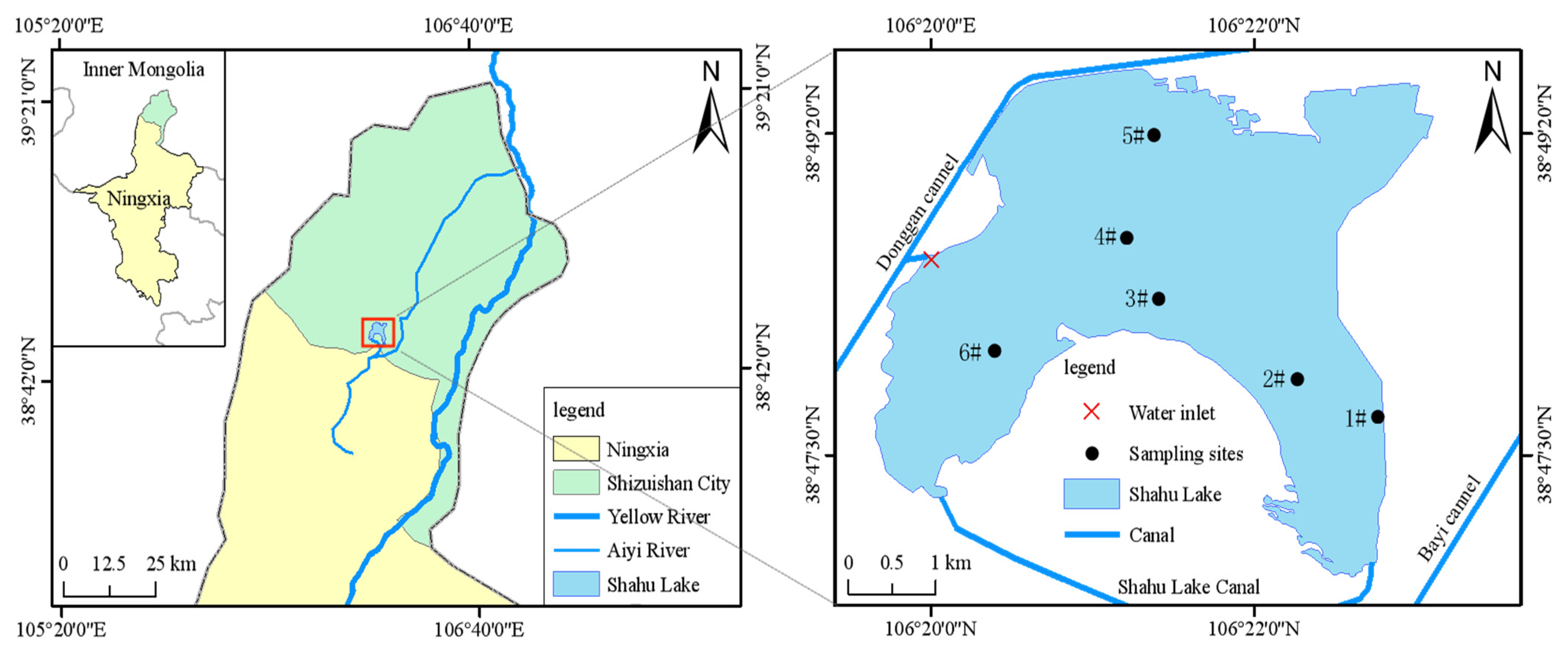
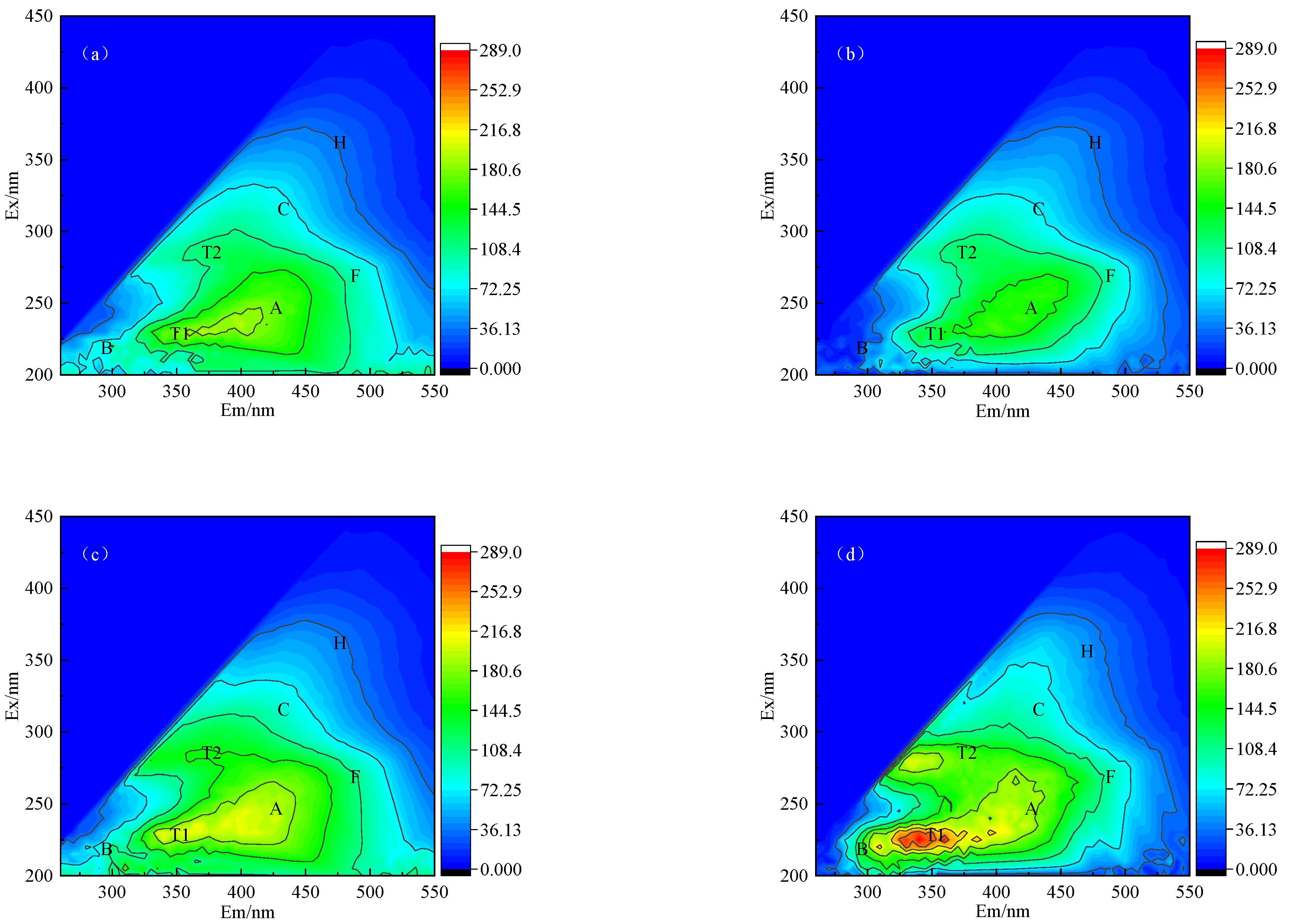
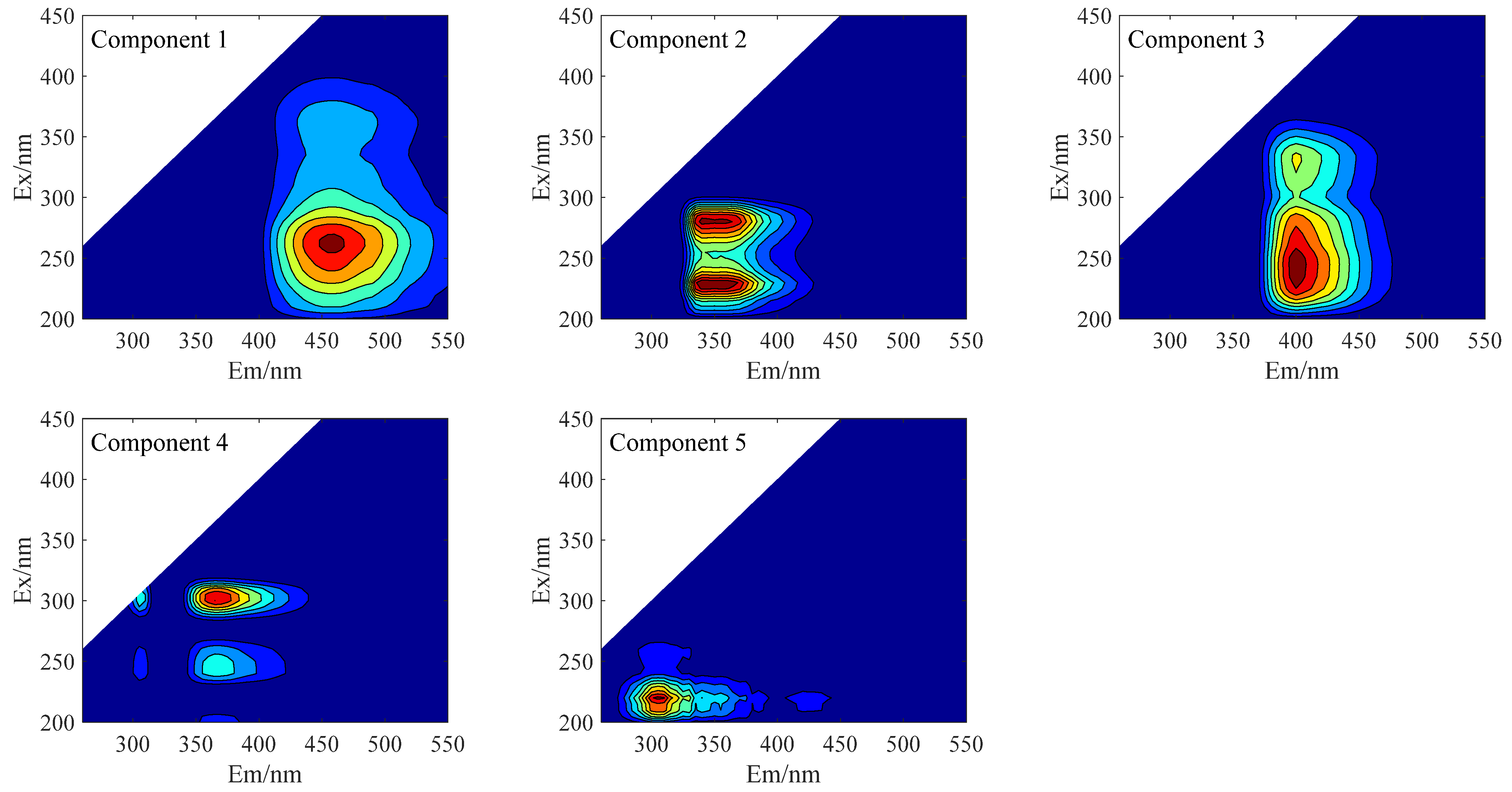


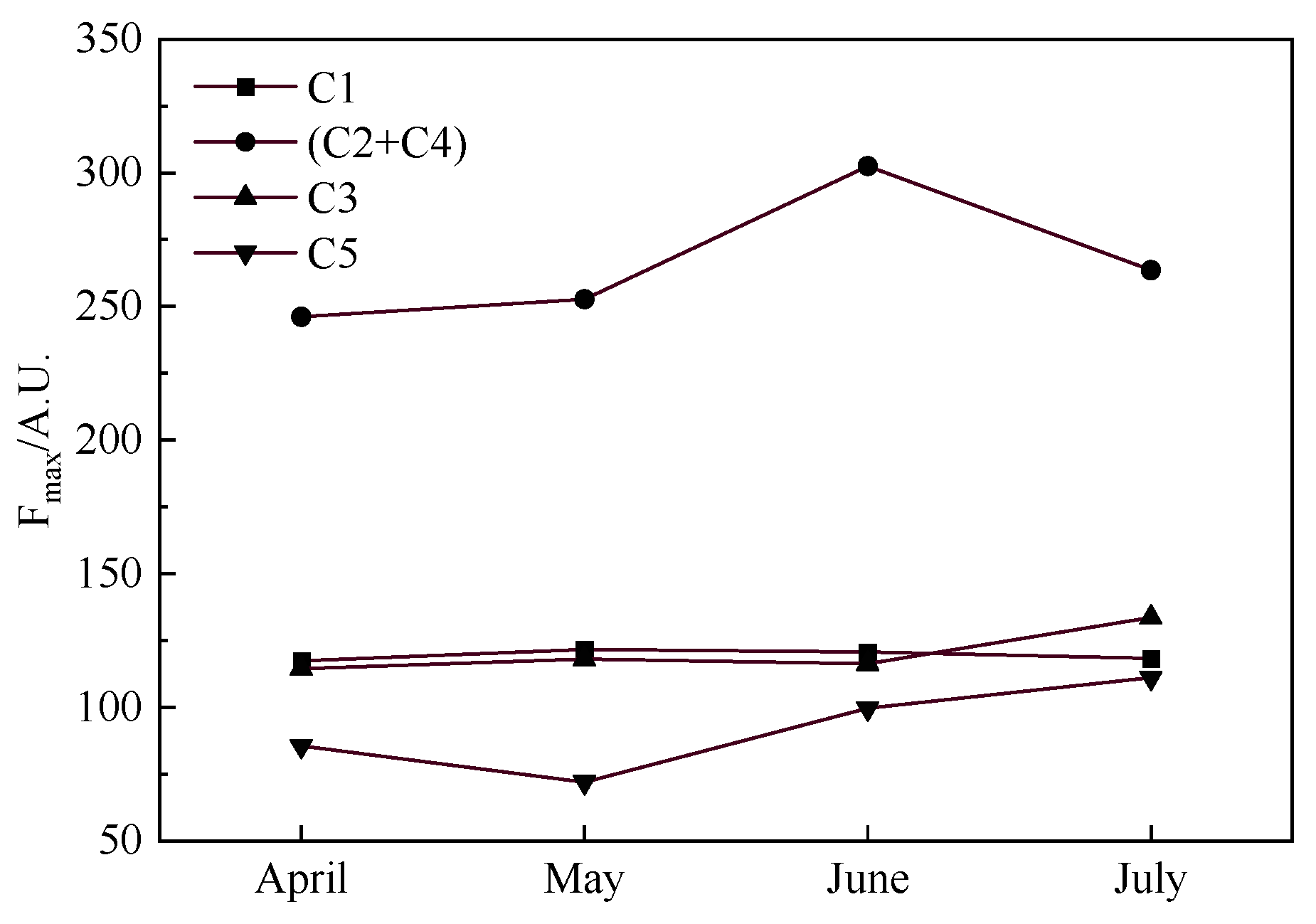
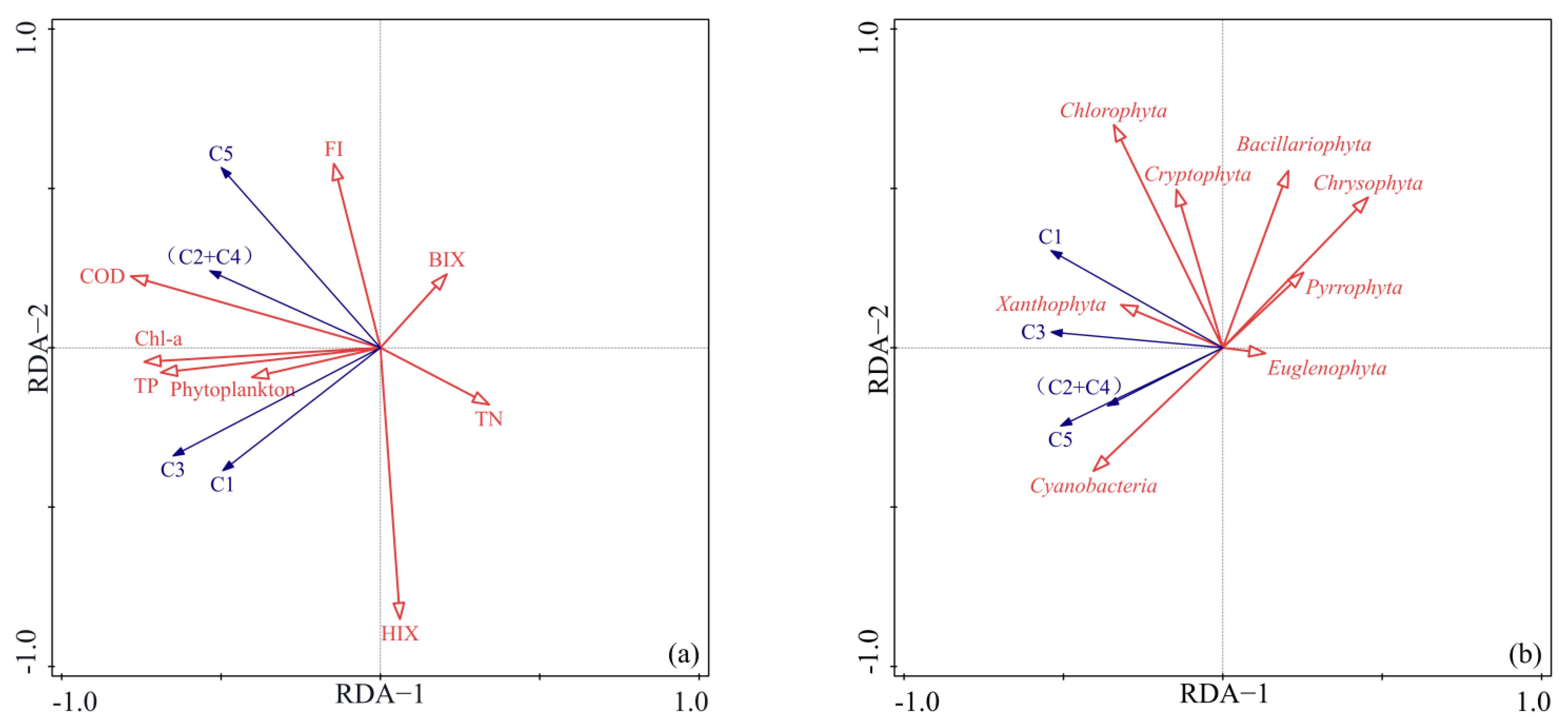
| Parameter | Methods | Units |
|---|---|---|
| CODCr | Potassium dichromate method | mg/L |
| TN | Ultraviolet spectrophotometry | mg/L |
| TP | Ammonium molybdate method | mg/L |
| Chl-a | Spectrophotometry (HJ 897-2017) [21] | μg/L |
| Component | λEx/λEm/nm | Characteristics | Traditional Peak Value |
|---|---|---|---|
| C1 | 260/460 | Terrestrial-humic-like, humic-acid-like | 260/488 [31] |
| C2 | 230, 280/340 | Tryptophan-like | 230/345 [15] 220–230, 280/320–336 [34] |
| C3 | 245/400 | Authigenic-humic-like, fulvic-acid-like | 235/397 [32] |
| C4 | 300/365 | Tryptophan-like | 295/370 [35] |
| C5 | 220/300 | Tyrosine-like | 220/305 [28] |
| Parameter | Spring (April–July) | Summer (July) | Shahu Lake |
|---|---|---|---|
| FI | 1.66 ± 0.05 | 1.77 ± 0.16 | 1.68 ± 0.10 |
| BIX | 1.20 ± 0.12 | 1.01 ± 0.02 | 1.15 ± 0.14 |
| HIX | 2.35 ± 0.36 | 2.19 ± 0.33 | 2.31 ± 0.36 |
| Parameter | Chl-a | Phytoplankton Density | TN | TP | CODCr | C1 | (C2+C4) | C3 | C5 | FI | BIX | HIX |
|---|---|---|---|---|---|---|---|---|---|---|---|---|
| Chl-a | 1 | - | - | - | - | - | - | - | - | - | - | - |
| Phytoplankton density | 0.697 ** | 1 | - | - | - | - | - | - | - | - | - | - |
| TN | −0.411 * | −0.60 ** | 1 | - | - | - | - | - | - | - | - | - |
| TP | 0.381 | 0.297 | −0.294 | 1 | - | - | - | - | - | - | - | - |
| CODCr | 0.559 ** | 0.427 * | −482 * | 0.591 ** | 1 | - | - | - | - | - | - | - |
| C1 | 0.277 | 0.14 | −0.064 | 0.463 * | 0.333 | 1 | - | - | - | - | - | - |
| (C2+C4) | 0.224 | 0.139 | −0.254 | 0.386 | 0.459 * | 0.627 ** | 1 | - | - | - | - | - |
| C3 | 0.645 ** | 0.395 | −0.183 | 0.381 | 0.410 * | 0.824 ** | 0.568 ** | 1 | - | - | - | - |
| C5 | 0.430 * | 0.168 | −0.247 | 0.292 | 0.532 ** | 0.344 | 0.503* | 0.336 | 1 | - | - | - |
| FI | 0.331 | 0.346 | −0.187 | −0.108 | −0.027 | −0.216 | 0.083 | −0.004 | 0.482 * | 1 | - | - |
| BIX | −0.580 ** | −0.261 | −0.117 | −0.037 | −0.124 | −0.183 | 0.374 | −0.364 | −0.238 | −0.185 | 1 | - |
| HIX | −0.068 | 0.134 | −0.149 | 0.087 | −0.337 | 0.308 | −0.183 | 0.222 | −0.545 ** | −0.368 | 0.009 | 1 |
Publisher’s Note: MDPI stays neutral with regard to jurisdictional claims in published maps and institutional affiliations. |
© 2022 by the authors. Licensee MDPI, Basel, Switzerland. This article is an open access article distributed under the terms and conditions of the Creative Commons Attribution (CC BY) license (https://creativecommons.org/licenses/by/4.0/).
Share and Cite
Zhang, Y.; Yang, F.; Liao, H.; Hu, S.; Yu, H.; Yuan, P.; Li, B.; Cui, B. Variation in Spectral Characteristics of Dissolved Organic Matter and Its Relationship with Phytoplankton of Eutrophic Shallow Lakes in Spring and Summer. Water 2022, 14, 2999. https://doi.org/10.3390/w14192999
Zhang Y, Yang F, Liao H, Hu S, Yu H, Yuan P, Li B, Cui B. Variation in Spectral Characteristics of Dissolved Organic Matter and Its Relationship with Phytoplankton of Eutrophic Shallow Lakes in Spring and Summer. Water. 2022; 14(19):2999. https://doi.org/10.3390/w14192999
Chicago/Turabian StyleZhang, Yimeng, Fang Yang, Haiqing Liao, Shugang Hu, Huibin Yu, Peng Yuan, Bin Li, and Bing Cui. 2022. "Variation in Spectral Characteristics of Dissolved Organic Matter and Its Relationship with Phytoplankton of Eutrophic Shallow Lakes in Spring and Summer" Water 14, no. 19: 2999. https://doi.org/10.3390/w14192999
APA StyleZhang, Y., Yang, F., Liao, H., Hu, S., Yu, H., Yuan, P., Li, B., & Cui, B. (2022). Variation in Spectral Characteristics of Dissolved Organic Matter and Its Relationship with Phytoplankton of Eutrophic Shallow Lakes in Spring and Summer. Water, 14(19), 2999. https://doi.org/10.3390/w14192999








